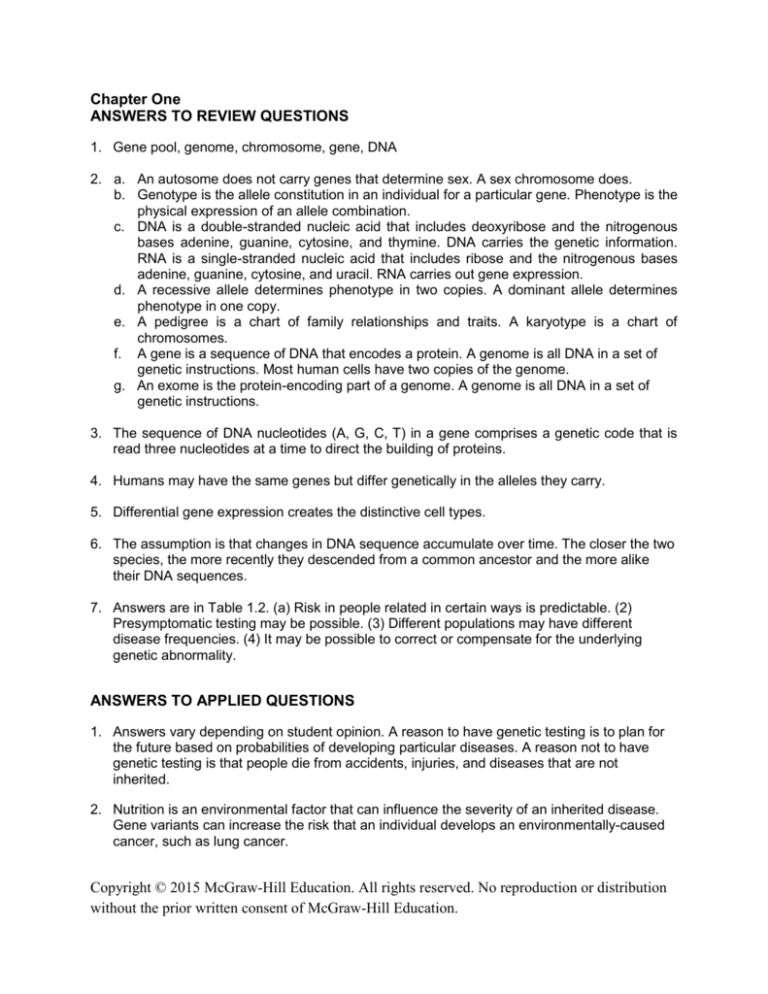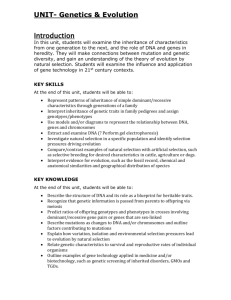
Chapter One
ANSWERS TO REVIEW QUESTIONS
1. Gene pool, genome, chromosome, gene, DNA
2. a. An autosome does not carry genes that determine sex. A sex chromosome does.
b. Genotype is the allele constitution in an individual for a particular gene. Phenotype is the
physical expression of an allele combination.
c. DNA is a double-stranded nucleic acid that includes deoxyribose and the nitrogenous
bases adenine, guanine, cytosine, and thymine. DNA carries the genetic information.
RNA is a single-stranded nucleic acid that includes ribose and the nitrogenous bases
adenine, guanine, cytosine, and uracil. RNA carries out gene expression.
d. A recessive allele determines phenotype in two copies. A dominant allele determines
phenotype in one copy.
e. A pedigree is a chart of family relationships and traits. A karyotype is a chart of
chromosomes.
f. A gene is a sequence of DNA that encodes a protein. A genome is all DNA in a set of
genetic instructions. Most human cells have two copies of the genome.
g. An exome is the protein-encoding part of a genome. A genome is all DNA in a set of
genetic instructions.
3. The sequence of DNA nucleotides (A, G, C, T) in a gene comprises a genetic code that is
read three nucleotides at a time to direct the building of proteins.
4. Humans may have the same genes but differ genetically in the alleles they carry.
5. Differential gene expression creates the distinctive cell types.
6. The assumption is that changes in DNA sequence accumulate over time. The closer the two
species, the more recently they descended from a common ancestor and the more alike
their DNA sequences.
7. Answers are in Table 1.2. (a) Risk in people related in certain ways is predictable. (2)
Presymptomatic testing may be possible. (3) Different populations may have different
disease frequencies. (4) It may be possible to correct or compensate for the underlying
genetic abnormality.
ANSWERS TO APPLIED QUESTIONS
1. Answers vary depending on student opinion. A reason to have genetic testing is to plan for
the future based on probabilities of developing particular diseases. A reason not to have
genetic testing is that people die from accidents, injuries, and diseases that are not
inherited.
2. Nutrition is an environmental factor that can influence the severity of an inherited disease.
Gene variants can increase the risk that an individual develops an environmentally-caused
cancer, such as lung cancer.
Copyright © 2015 McGraw-Hill Education. All rights reserved. No reproduction or distribution
without the prior written consent of McGraw-Hill Education.
3. Perhaps a facial image derived from DNA data and displayed in public without the
individual’s permission can be treated as illegal use of any identifying photograph. The fact
that DNA is involved may introduce a greater level of intrusion into one’s privacy, particularly
if it is obtained from garbage, such as discarded gum.
ANSWERS TO WEB ACTIVITIES
1. Answers vary depending on website visited and student opinion. FDA has restricted DTC
genetic testing to ancestry.
2. Section 4.5 presents another case of diagnosis from exome sequencing, for a little girl, Bea
Rienhoff. “One of a Kind” is an article in The New Yorker from July 21, 2014, about a boy
with mutation in a gene called NGLY1.
3. Disaster victim identification: http://www.dna-worldwide.com/forensic-dna-testing/disastervictim-identification/
4. Parents might want to know what exactly will be done with their children’s DNA at the time of
collection and going forward; who will have access to the information; and how the
information will be protected.
5. Baylor College of Medicine began one of the first large-scale programs to sequence exomes
and genomes of difficult-to-diagnose cases. https://www.bcm.edu/research/medicalgenetics-labs/test_detail.cfm?testcode=1500
ANSWERS TO FORENSICS FOCUS
1. A difficult question. The repeats do not encode protein so likely do not affect the phenotype
and therefore are likely not subject to natural selection. Therefore the sequences do not
determine traits, health, nor do they reveal anything about ancestry because the number of
repeats can spontaneously change. See chapter 14 for more detail.
2. Genetic information might be useful in a legal case if a particular genotype can account for a
very specific behavior that caused a person to commit a crime.
3. Broaden question beyond TV series—cat and dog hairs used to identify crime scenes.
Here’s a good case: http://sandiegolawlibrary.org/straaaaange-cases-cat-dna-databaseconvicts-a-killer/
4. a. Taking part of a dead person’s body is indeed an invasion of privacy.
b. Dr. House is much too quick to diagnose. Appropriately used genetic tests would help him
differentiate among explanations for symptoms and other laboratory test results.
Copyright © 2015 McGraw-Hill Education. All rights reserved. No reproduction or distribution
without the prior written consent of McGraw-Hill Education.











